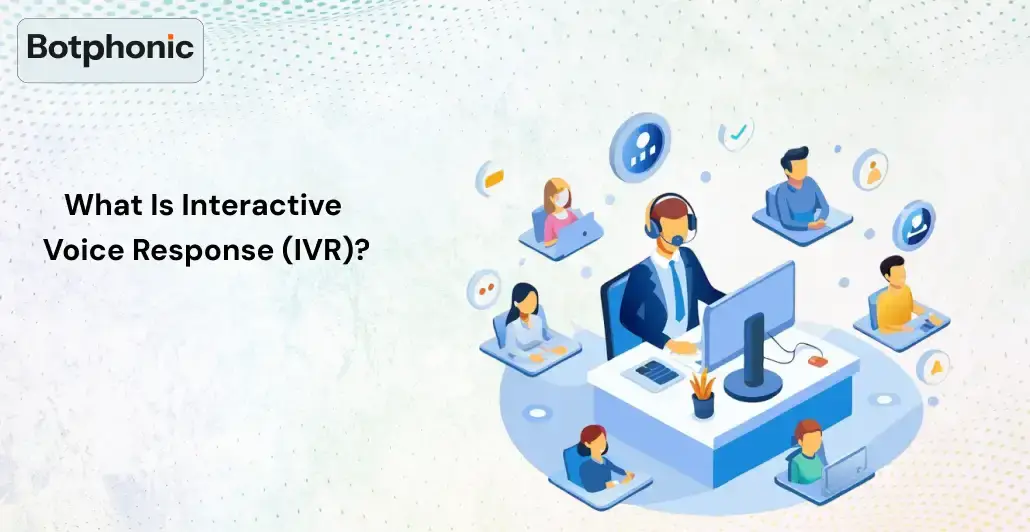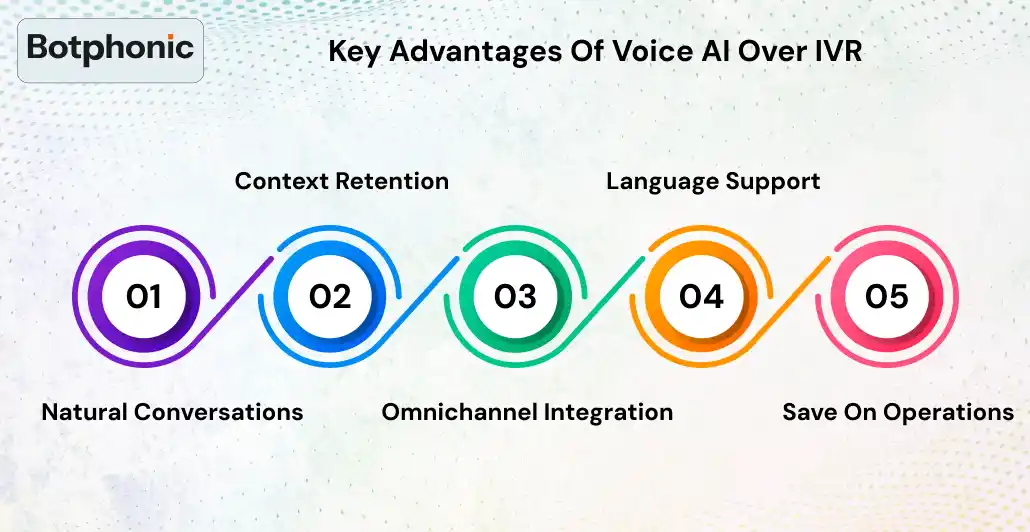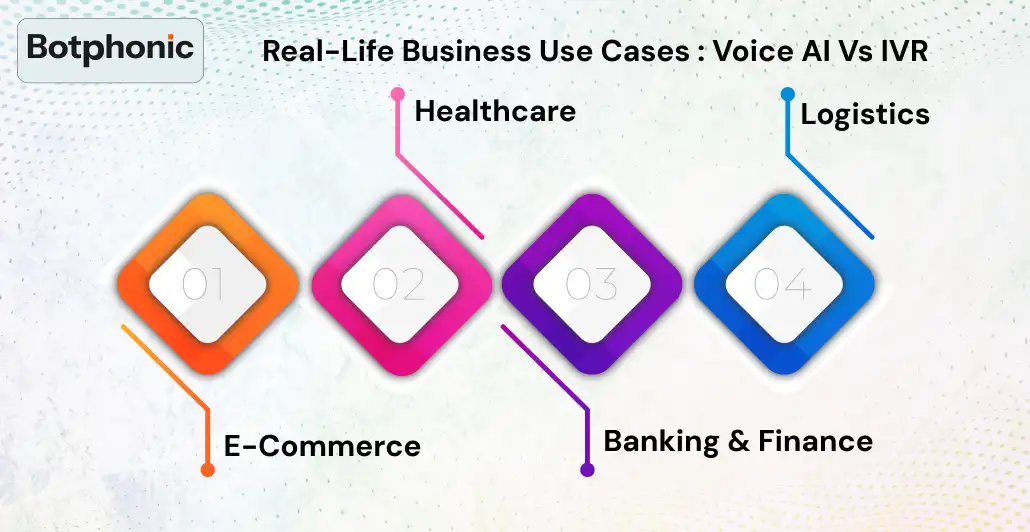
Summarize Content With:
Summary
This blog will examine the differences between voice AI technology and IVR technology and the role that modern AI call assistants can play in helping businesses to improve their customer experience as well as lower their operation costs and eventually lead to growth, and more so to small businesses.
Introduction
Making a customer listen to a friendly, caring voice on the phone, one that knew exactly what they wanted and did not need to press buttons. Spending a lot of time while waiting in the queue just to find that the conversation is misinterpreted?
Sounds nice, doesn’t it?
This is precisely what is happening with the increasing prominence of Voice AI vs. IVR. As companies seek more intelligent methods to bridge the gap, customer service has become an increasingly unfriendly experience. However, with tools such as AI call assistants, the customer service process is becoming fluid and conversational. So, why is Voice AI not only a trend but also the future of communication?
What is IVR?

IVR is a technology-based phone customer interaction automation system. The IVR systems were introduced in the 1980s, and they were intended to save on labour by enabling callers to navigate their way through pre-recorded messages based on keypad entries.
An IVR menu may sound as follows:
“Hello! Welcome to the XYZ Company. Press one if you want to talk to Sales, press 2 to talk to Support, and press 3 to talk to an agent.”
Although IVR has always been regarded as a cost-efficient technology that is still commonly employed, it seldom provides flexibility, customisation, or natural conversation. IVR systems operate on decision trees, which are limited in their ability to handle complex or unexpected requests.
Limitations of IVR:
- Menus are long and perplexing.
- Bad at interpreting natural language.
- Most of the time, it results in repeat calls because problems have not been addressed.
- Comes off as unfeeling and mechanical.
Nevertheless, IVR has a fundamental use in call routing, despite its disadvantages. Nonetheless, its weaknesses are driving many to alternatives that run on AI.
What is Voice AI? A Smarter Way to Talk to Customers
Voice AI refers to the systems of artificial intelligence that recognise and can answer human voices through high-level speech recognition and natural language processing. Voice AI can make sense of real human conversations, unlike IVR, and learn and personalise responses, as opposed to IVR.
It is designed as a conversational AI voice helper that performs according to the command and interprets the purpose.
It is equal to being a conversational AI voice assistant, not a servant who takes orders, but a machine that reads minds.
Let’s compare:
- One of them calls and says they want to know the status of their last order.
- An IVR will fail to note a request unless it is pre-nutritioned.
- The main intent will be extracted
- Then the AI voice assistant will help it check the order status and provide an answer.
The Wall Street Journal states that artificial intelligence has advanced to a new standard of voice agents that possess an AI capability to handle customer service requests with unprecedented levels of human-like qualities. According to experts quoted by the paper, the industry is expected to integrate new contact centres with generative AI in 2028, a significant change in the logic of voice systems, moving from the strict automation stage to a more experimental, conversational one.
Key Advantages of Voice AI Over IVR

1. Natural Conversations
The largest benefit of AI-assisted text or an AI real voice solution is that it allows two-way conversations that are natural, like when talking to a trained human agent. Customers will not have to repeat and memorise any options.
2. Context Retention
The correct voice assistant will always be AI-powered. As an illustration, when an individual makes two calls about the same issue, the system will be able to remember the past information, like some of the previous discussions, which cannot be done with traditional IVR systems.
3. Omnichannel Integration
Today, AI voice assistants and platforms may naturally integrate with CRM systems, email, and chatbots, supplying businesses with a 360-degree perspective on the connection between customers.
4. Language Support
Voice AI will automatically recognise and alternate between languages depending on the user’s voice, thereby eliminating the annoyance of having to push buttons to choose a preferred language.
5. Save On Operations
Voice AI will help you minimise the use of agents, unlike in normal call centres. It will be helpful where a large human team is needed before services can be handled.
Real-Life Business Use Cases: Voice AI vs IVR

1. E-Commerce
A voice AI assistant can offer order tracking, returns, and FAQs to an online retailer. The assistant knows how to answer or interpret open-ended questions, whereas IVR takes longer because it does not understand open-ended queries.
2. Healthcare
An example of a clinic using AI voice is that, after making an appointment with a particular clinic, it informs or reminds patients of the appointment, reschedules, and even gathers basic information about their symptoms.
3. Banking & Finance
A financial industry player switches its IVR to a chatty voice AI that assists customers in checking their balances, identifying potential fraud, and requesting loans without requiring a live interaction.
4. Logistics
AI voice companies enhance the way logistics companies deliver: by utilising these companies, delivery companies can automate delivery confirmation, send delay reminders, and inform users in real-time as they speak.
Why Small Businesses Should Pay Attention
Some small companies believe that voice AI is only suitable for large corporations. This is no longer true. As its accessibility grows and a cost-reduction trend continues, startups can now add an AI call assistant entity with no need for comprehensive IT staffing.
Best cases to use Voice AI in small businesses:
- It provides a competitive advantage in the area of customer service.
- Minimises the calls missed or mishandled.
- Increases its volume without human resources.
- Works around the clock – even.
Seeking the top IVR system for small businesses? The question is: why do we have to satisfy with IVR when voice AI is not that far away?
What to Look for in Voice AI Providers
The voice AI market is flooding too quickly with similar companies, and not all of them are equal. To find the appropriate solution for your business, you will need to rise above the term ‘buzzwords’ and concentrate on actual functionality.
Voice AI show as relevant as far as comparing a few providers is concerned. An AI-powered voice assistant will work with growth.
1. Ease of Use
User-friendly search solutions. A call assistant can easily be configure without requiring a developer, especially for small businesses. An effective system has a user-friendly dashboard, easy-to-understand analytics, and is easy to install.
2. Natural Voice Quality
Superior AI real voice systems are not built to be differentiated from a human being. Do not use robot-like assistants; instead, form a positive impression of the customers. Ensure that the system employs high-quality text-to-speech with emotional intonation.
3. Context Awareness
A voice assistant AI should remember the context in a dialogue. To illustrate, when a customer asks for their name or informs them about an earlier order, the assistant should be able to respond appropriately in such cases.
4. Multilingual Support
Does your firm have a wide customer base? Conversational AI voice tools help you work with many languages seamlessly, without requiring a button to be pressed to detect it.
5. Scalability
Your AI solution must correspond to your growth needs. Select a platform that allows for growing call volume, more advanced use cases (e.g., outbound calling), and CRM and ticketing integration.
6. Reporting and analytics
The best companies in the AI voice business provide infinite analytics. That consists of conversation summaries, intent recognition, and performance insights, assisting you to continuously improve how your assistant accommodates customers.
7. Information Protection & Privacy
Various regulations are present on privacy, which should be followed by a provider, such as the GDPR. The customer’s voice information is confidential and handle with care.
| Feeling upgraded? Try Botphonic |
If you need a platform that unites all the above, it is easy to set up, features natural language processing, offers stunning voice quality, and provides smart integrations. Botphonic is an excellent choice to start a small business.
It unites all the necessary elements of an efficient AI call assistant, providing the customer with a system that is less machine-like and more human-like, facilitating a conversation. Are you a startup or a rapidly growing company? Botphonic will allow you to automate smartly without losing human contact.
Join Botphonic now and offer your customers the voice experience they’ve been waiting for.
Final Thoughts
It is crucial to choose the better technology for voice AI versus IVR to provide a better experience for consumers. Whether there are thousands of calls or a few dozen, AI will help greet those customers is the first impression of the brand.
The future of communication is already here. Customers want more than just button-press menus. Engage them in conversation, improving workflows. Enter conversational AI, which can make that happen at any scale.
If you are ready to go beyond the old systems and realise actual conversations, explore Voice AI now.
Looking to give your customer support a fresh new look? See how Botphonic can help you bring Voice AI to life.

